Resource Center OLLibrary
|
12 |
|
[1492-1493 |
When the sun rose it revealed a low sandy
shore. It was the humble threshold of the New World.
Columbus, richly dressed in scarlet, landed with
his men. Kneeling, they kissed the soil, and with tears gave
thanks to God for having crowned their voyage with success. Then,
with solemn ceremonies, the Admiral planted the royal
flame-colored banner
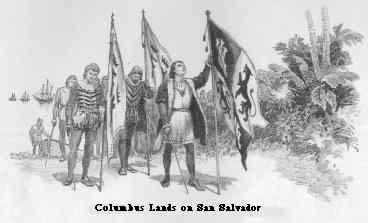
of Spain, and took possession of the country for Ferdinand and
Isabella. To the island he gave the name of San Salvador, or the
Holy Redeemer.
Columbus believed this little island to be part
of the Indies which he was seeking. Since he had reached it by
sailing westward he called the group to which it belongs the West
Indies. To the natives he naturally gave the name Indians.
Columbus never found out his mistake in regard
to this country. He made three more voyages hither; but he died
firmly convinced that America was part of Asia, and that he had
discovered a short and direct all-sea route westward from Europe
to the Indies.
We should distinctly understand that Columbus
never saw any part of the mainland of what is now the United
States.
12. Columbus returns to Spain; his Reception;
the Pope's Division of the World. Columbus built a small fort
in Haiti and left a few men to hold it. He then sailed for Spain
(1493).
|
1493-1494] |
|
13 |
|
Ferdinand and Isabella gave the great sailor such a reception as the first civilized man who had crossed the Atlantic merited. Those who a year before had laughed at him as crazy, now, cap in hand, bowed low before him. Yet the only printed account which appeared describing his wonderful voyage was a copy of a letter which he had written to the King and Queen. It was entitled:
|
|
14 |
|
[1493-1500 |
|
Loud was the outcry against
Columbus. The rabble nicknamed him the "Admiral of
Mosquito Land." They pointed So strong was the feeling against him that the King appointed a new governor for the island of Haiti (§12). He arrested Columbus and sent him back in chains to Spain (1500). He was released as soon as he arrived, and lived to make one more voyage. Broken in health, broken in heart, the great sailor died in Spain in neglect and poverty.1 But though his closing days were
pitiful, yet none the less the voice that he imagined he
once heard in a dream spoke truly.2 He had
accomplished what no one else had done, for he had
unlocked those gates of the ocean," which until |
|
1497] |
|
15 |
|
|
|
16 |
|
[1497-1499 |
|
"In the year of our Lord 1497,
John Cabot, a Venetian, and his son Sebastian discovered
that country which no one before his time had ventured to
approach, on the 24th of June, about five o'clock in the
morning." |
|
1499-1507] |
|
17 |
|
|
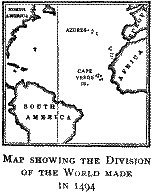 One
important result of this supposed discovery of a western
route to the Indies was the division of the world by the
Pope. Spain and Portugal were rivals. Both were eager to
get control of the commerce with the Far East --
especially with the Spice Islands of the Indies. In order
to keep the two nations from fighting each other, the
Pope drew a perpendicular line, one hundred leagues west
of the Azores, from the north pole to the south pole. The
King of Portugal was to have all lands discovered east of
that line, and the King of Spain all those west of it.
Later (1494), this dividing line was fixed three hundred
and seventy leagues west of the Cape Verde Islands.
One
important result of this supposed discovery of a western
route to the Indies was the division of the world by the
Pope. Spain and Portugal were rivals. Both were eager to
get control of the commerce with the Far East --
especially with the Spice Islands of the Indies. In order
to keep the two nations from fighting each other, the
Pope drew a perpendicular line, one hundred leagues west
of the Azores, from the north pole to the south pole. The
King of Portugal was to have all lands discovered east of
that line, and the King of Spain all those west of it.
Later (1494), this dividing line was fixed three hundred
and seventy leagues west of the Cape Verde Islands.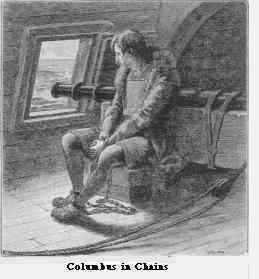 at
him as the man who had promised everything, but who had
found nothing but "a wilderness peopled with naked
savages."
at
him as the man who had promised everything, but who had
found nothing but "a wilderness peopled with naked
savages."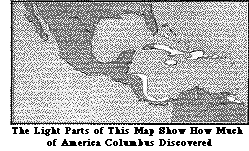 then
had been "fast shut with chains," -- the chains of
ignorance and fear. He failed to find the Indies -- but
he did something immeasurably greater -- he discovered
America.
then
had been "fast shut with chains," -- the chains of
ignorance and fear. He failed to find the Indies -- but
he did something immeasurably greater -- he discovered
America.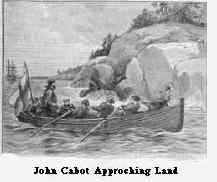 destined
to be the first to look on the mainland of America, nor
was he to give it the name it bears. The discovery of the
continent was made by a fellow-countryman, John Cabot, of
Venice, then residing in Bristol, England. The great
voyage of Columbus moved him to see what he could
discover. He hoped to find a northern passage to the
Indies and China, in order that he might secure the spice
trade for the English sovereign. He failed to discover
what he sought; but he did better, for he saw what no
civilized man had yet beheld, -- the continent of North
America. The point where he made the discovery was
probably in the vicinity of Cape Breton Island, at the
entrance to the Gulf of St. Lawrence. On a map drawn by
his son Sebastian we read the following inscription:
destined
to be the first to look on the mainland of America, nor
was he to give it the name it bears. The discovery of the
continent was made by a fellow-countryman, John Cabot, of
Venice, then residing in Bristol, England. The great
voyage of Columbus moved him to see what he could
discover. He hoped to find a northern passage to the
Indies and China, in order that he might secure the spice
trade for the English sovereign. He failed to discover
what he sought; but he did better, for he saw what no
civilized man had yet beheld, -- the continent of North
America. The point where he made the discovery was
probably in the vicinity of Cape Breton Island, at the
entrance to the Gulf of St. Lawrence. On a map drawn by
his son Sebastian we read the following inscription: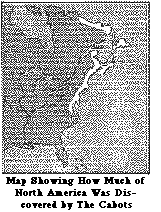 Cabot
planted the English flag on the coast, and took
possession of the country for Henry VII, King of
England.
Cabot
planted the English flag on the coast, and took
possession of the country for Henry VII, King of
England.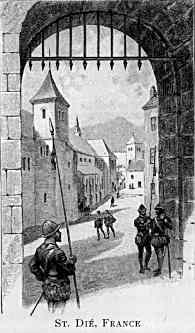 part
of the South American coast, somewhere in what is now
Dutch Guiana. In the course of the next four years he
made two more voyages in which he visited Brazil.
part
of the South American coast, somewhere in what is now
Dutch Guiana. In the course of the next four years he
made two more voyages in which he visited Brazil.


